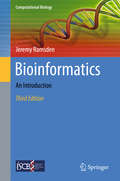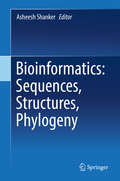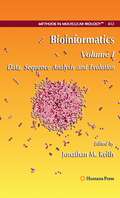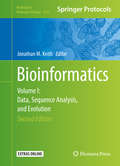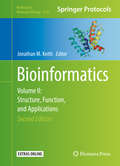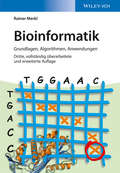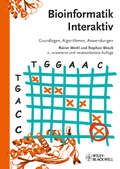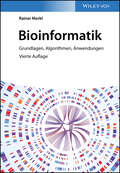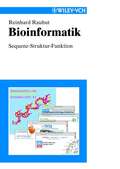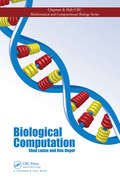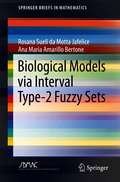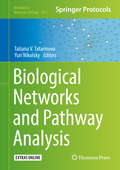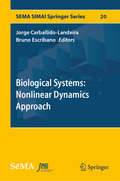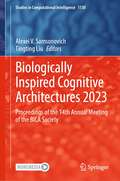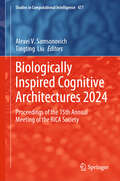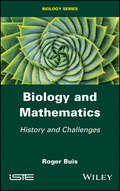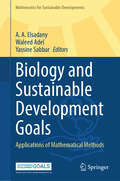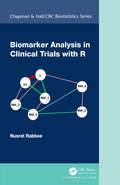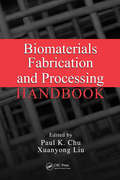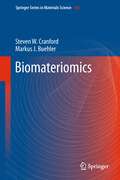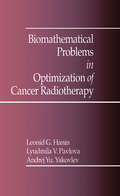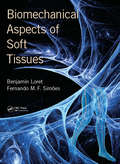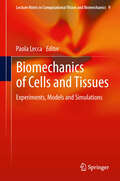- Table View
- List View
Bioinformatics: An Introduction (Computational Biology #21)
by Jeremy RamsdenThis comprehensive textbook presents a self-contained guide to bioinformatics, defined in its broadest sense as the application of information science to biology. Thoroughly updated and greatly expanded, this third edition now includes material on the growing array of "-omics"; covering metagenomics, toxicogenomics, glycomics, lipidomics, microbiomics and phenomics. New chapters have also been added on ecosystems management and the nervous system. Emphasis is placed on providing both a firm grounding in the core concepts and a clear overview of the complete field of bioinformatics. Features: explains the fundamentals of information science relevant to biology; covers both organismal (ontogeny and phylogeny, as well as genome structure) and molecular aspects; examines the most important practical applications of bioinformatics, providing detailed descriptions of both the experimental process and the data analysis; provides a varied selection of problems throughout the book, to stimulate further thinking.
Bioinformatics: Sequences, Structures, Phylogeny
by Asheesh ShankerThis book provides a comprehensive overview of the concepts and approaches used for sequence, structure, and phylogenetic analysis. Starting with an introduction to the subject and intellectual property protection for bioinformatics, it guides readers through the latest sequencing technologies, sequence analysis, genomic variations, metagenomics, epigenomics, molecular evolution and phylogenetics, structural bioinformatics, protein folding, structure analysis and validation, drug discovery, reverse vaccinology, machine learning, application of R programming in biological data analysis, and the use of Linux in handling large data files.
Bioinformatics: Volume I: Data, Sequence Analysis and Evolution (Methods in Molecular Biology #452)
by Jonathan M. KeithIn this book, leading researchers in the field of Bioinformatics provide a selection of the most useful and widely applicable methods, able to be applied as is, or with minor variations, to many specific problems. Over 80 authors from around the globe contribute to the two volumes, including many leading experts in their respective subjects. They encompass topics from across the diverse field of bioinformatics through its broad scope, combining to provide an inter-disciplinary collaboration involving biologists, biochemists, physicists, mathematicians, statisticians and computer scientists.
Bioinformatics: Volume I: Data, Sequence Analysis, and Evolution (Methods in Molecular Biology #1525)
by Jonathan M. KeithIn Bioinformatics, leading researchers provide a selection of the most useful and widely applicable methods, able to be applied as is, or with minor variations, to many specific problems. Volume II: Structure, Function and Applications contains methods pertinent to the prediction of protein and RNA structures and the analysis and classification of structures, methods for inferring the function of previously identified genomic elements, chiefly protein-coding genes, medical applications in diagnostics and drug discovery, and "meta-methods" for developers of bioinformatics algorithms. Over 80 authors from around the globe have contributed to the two volumes.
Bioinformatics: Volume II: Structure, Function, and Applications (Methods in Molecular Biology #1526)
by Jonathan M. KeithIn Bioinformatics, leading researchers provide a selection of the most useful and widely applicable methods, able to be applied as is, or with minor variations, to many specific problems. Volume II: Structure, Function and Applications contains methods pertinent to the prediction of protein and RNA structures and the analysis and classification of structures, methods for inferring the function of previously identified genomic elements, chiefly protein-coding genes, medical applications in diagnostics and drug discovery, and "meta-methods" for developers of bioinformatics algorithms. Over 80 authors from around the globe have contributed to the two volumes.
Bioinformatik
by Rainer MerklDie zweite Auflage dieses erfolgreichen Lehrbuchs ist vollständig überarbeitet und in großen Teilen erweitert. Insbesondere wurde die Behandlung der Genomdatenanalyse deutlich vertieft und es wurden Kapitel über maschinelles Lernen, bayessche Netzwerke sowie Protein- und Enzymdesigns und über die Auswertung von Microarrays eingeführt. Außerdem steht dem Leser jetzt eine attraktive Webseite mit Zusatzmaterial und Fragen zum Stoff zur Verfügung. Webseite mit Zusatzmaterial und Fragen: WWW. WILEY-VCH. DE/HOME/BIOINFORMATIK
Bioinformatik Interaktiv
by Stephan Waack Rainer MerklDie zweite Auflage dieses erfolgreichen Lehrbuchs ist vollständig überarbeitet und in großen Teilen erweitert. Insbesondere wurde die Behandlung der Genomdatenanalyse deutlich vertieft und es wurden Kapitel über maschinelles Lernen, bayessche Netzwerke sowie Protein- und Enzymdesigns und über die Auswertung von Microarrays eingeführt. Außerdem steht dem Leser jetzt eine attraktive Webseite mit Zusatzmaterial und Fragen zum Stoff zur Verfügung. Webseite mit Zusatzmaterial und Fragen: WWW.WILEY-VCH.DE/HOME/BIOINFORMATIK
Bioinformatik: Grundlagen, Algorithmen, Anwendungen
by Rainer MerklBioinformatik Der Marktführer bei den Bioinformatiklehrbüchern in neuer Auflage und mit dem neuen Thema Molekulardynamik Bioinformatik ist eine Kerndisziplin in den modernen Biowssenschaften, von der Biotechnologie über die Biochemie und Molekularbiologie bis zur Molekulargenetik und Molekularmedizin. Sie ist eine essenzielle Grundlage für alle “omics”-Technologien, für die Strukturbiologie, die Systembiologie sowie die synthetische Biologie. Bioinformatik. Grundlagen, Algorithmen, Anwendungen bietet eine umfassende Einführung in die wichtigsten Methoden der Bioinformatik. Der Autor erklärt dabei sowohl die mathematischen und biologischen Grundlagen als auch die wichtigsten Software-Tools und deren Anwendungsbereiche. Schwerpunkte sind Methoden zum Sequenzvergleich, Verfahren zur Charakterisierung von Proteinfamilien, Algorithmen zur Vorhersage von Protein- und RNA-Strukturen, Methoden des maschinellen Lernens und das Proteindesign. Für die 4. Auflage wurde der Text durchgehend aktualisiert und um ein Kapitel zur Molekulardynamik erweitert. Neu aufgenommene Exkurse zu Meilensteinen der Bioinformatik und aktuellen Anwendungsgebieten lockern den Text auf. Auf der ebenfalls komplett überarbeiteten Begleit-Webseite werden interaktive Lernmodule bereitgestellt, einschließlich mehr als 120 Übungsaufgaben, zum Teil mit Lösungen. Eine perfekte Einführung für alle Studenten der Lebenswissenschaften oder Informatik, die einen Einblick in die gängigen Methoden der Bioinformatik benötigen, sowie ein wertvoller Begleiter für alle, die bereits bioinformatische Werkzeuge nutzen und die zugrundeliegenden Konzepte verstehen möchten.
Bioinformatik: Sequenz - Struktur - Funktion
by Reinhard RauhutDie Bioinformatik ist für die Weiterentwicklung der modernen Biowissenschaften von herausragender Bedeutung. In Grundzügen wird sie Teil einer jeden Ausbildung zum Biologen oder Biochemiker werden. Obwohl die Zahl der angebotenen Lehrveranstaltungen rapide zunimmt, gibt es bisher auf dem deutschsprachigen Markt noch kein Lehrbuch zu dieser Thematik. Das vorliegende Werk schließt diese Lücke. Reich bebildert und mit relativ wenig mathematischem Formelaufwand werden die Grundlagen der Bioinformatik gut verständlich aufbereitet. Die Themenauswahl ist dabei auf die Bedürfnisse der experimentell tätigen Biochemiker, Biologen und Mediziner abgestimmt. Auf die wichtigsten Hilfsmittel, die das Internet kostenlos bietet, wird ausführlich eingegangen. Die Inhalte werden in der Abfolge Sequenz - Struktur - Funktion entwickelt: · Sequenzdatenbanken · Genomprojekte · Proteinorientierte Datenbanken · Techniken des eukaryontischen Genomassembly · Strukturdatenbanken · Expressionsanalyse mit DNA Chips · Proteomics · Phylogenie und Sequenz · DNA Computing Die Bioinformatik betrifft die tägliche Arbeit eines jeden Biowissenschaftlers. Es sollte sich daher jeder mit den grundlegenden Ansätzen vertraut machen.
Biological Clocks, Rhythms, and Oscillations: The Theory of Biological Timekeeping (The\mit Press Ser.)
by Daniel B. ForgerAn introduction to the mathematical, computational, and analytical techniques used for modeling biological rhythms, presenting tools from many disciplines and example applications.All areas of biology and medicine contain rhythms, and these behaviors are best understood through mathematical tools and techniques. This book offers a survey of mathematical, computational, and analytical techniques used for modeling biological rhythms, gathering these methods for the first time in one volume. Drawing on material from such disciplines as mathematical biology, nonlinear dynamics, physics, statistics, and engineering, it presents practical advice and techniques for studying biological rhythms, with a common language. The chapters proceed with increasing mathematical abstraction. Part I, on models, highlights the implicit assumptions and common pitfalls of modeling, and is accessible to readers with basic knowledge of differential equations and linear algebra. Part II, on behaviors, focuses on simpler models, describing common properties of biological rhythms that range from the firing properties of squid giant axon to human circadian rhythms. Part III, on mathematical techniques, guides readers who have specific models or goals in mind. Sections on “frontiers” present the latest research; “theory” sections present interesting mathematical results using more accessible approaches than can be found elsewhere. Each chapter offers exercises. Commented MATLAB code is provided to help readers get practical experience. The book, by an expert in the field, can be used as a textbook for undergraduate courses in mathematical biology or graduate courses in modeling biological rhythms and as a reference for researchers.
Biological Computation (Chapman & Hall/CRC Computational Biology Series)
by Ehud Lamm Ron UngerThe area of biologically inspired computing, or biological computation, involves the development of new, biologically based techniques for solving difficult computational problems. A unified overview of computer science ideas inspired by biology, Biological Computation presents the most fundamental and significant concepts in this area. In the book
Biological Models via Interval Type-2 Fuzzy Sets (SpringerBriefs in Mathematics)
by Rosana Sueli Jafelice Ana Maria Amarillo BertoneThis book offers a gentle introduction to type-2 fuzzy sets and, in particular, interval type-2 fuzzy sets and their application in biological modeling. Interval type-2 fuzzy modeling is a comparatively recent direction of research in fuzzy modeling. As the modeling of biological problems is inherently uncertain, the use of fuzzy sets in this field is a natural choice.The coverage begins with a succinct review of type-1 fuzzy basic theory, before providing a comprehensive and didactic explanation of type-2 fuzzy set components. In turn, Fuzzy Rule-Based Systems, or FRBS, are shown for both types, interval type-2 and type-1 fuzzy sets.Applications include the pharmacological models, prediction of prostate cancer stages, a model for HIV population transfer (asymptomatic to symptomatic), an epidemiological disease caused by HIV, some models in population growth, included the Malthus Model, and an epidemic model refers to COVID-19. The book is ideally suited to graduate students in mathematics and related fields, professionals, researchers, or the public interested in interval type-2 fuzzy modeling. Largely self-contained, it can also be used as a supplementary text in specialized graduate courses.
Biological Networks and Pathway Analysis (Methods in Molecular Biology #1613)
by Yuri Nikolsky Tatiana V. TatarinovaIn this volume, expert practitioners present a compilation of methods of functional data analysis (often referred to as "systems biology") and its applications in drug discovery, medicine, and basic disease research. It covers such important issues as the elucidation of protein, compound and gene interactions, as well as analytical tools, including networks, interactome and ontologies, and clinical applications of functional analysis. As a volume in the highly successful Methods in Molecular Biology series, this work provides detailed description and hands-on implementation advice. Reputable, comprehensive, and cutting-edge, Biological Networks and Pathway Analysis presents both "wet lab" experimental methods and computational tools in order to cover a broad spectrum of issues in this fascinating new field.
Biological Systems: Nonlinear Dynamics Approach (SEMA SIMAI Springer Series #20)
by Jorge Carballido-Landeira Bruno EscribanoThis book collects recent advances in the field of nonlinear dynamics in biological systems. Focusing on medical applications as well as more fundamental questions in biochemistry, it presents recent findings in areas such as control in chemically driven reaction-diffusion systems, electrical wave propagation through heart tissue, neural network growth, chiral symmetry breaking in polymers and mechanochemical pattern formation in the cytoplasm, particularly in the context of cardiac cells. It is a compilation of works, including contributions from international scientists who attended the “2nd BCAM Workshop on Nonlinear Dynamics in Biological Systems,” held at the Basque Center for Applied Mathematics, Bilbao in September 2016. Embracing diverse disciplines and using multidisciplinary approaches – including theoretical concepts, simulations and experiments – these contributions highlight the nonlinear nature of biological systems in order to be able to reproduce their complex behavior. Edited by the conference organizers and featuring results that represent recent findings and not necessarily those presented at the conference, the book appeals to applied mathematicians, biophysicists and computational biologists.
Biologically Inspired Cognitive Architectures 2023: Proceedings of the 14th Annual Meeting of the BICA Society (Studies in Computational Intelligence #1130)
by Alexei V. Samsonovich Tingting LiuThe book focuses on original approaches intended to support the development of biologically inspired cognitive architectures. It bridges together different disciplines, including artificial intelligence, linguistics, neuro- and social sciences, psychology and philosophy of mind, among others. The chapters are based on contributions presented at the 2023 Annual International Conference on Brain-Inspired Cognitive Architectures for Artificial Intelligence (the 14th Annual Meeting of the BICA Society, BICA*AI 2023), organized in collaboration with the University of Ningbo and held on October 13-15, 2023, in Ningbo, China. The book discusses emerging methods, theories and ideas towards the realization of general-purpose humanlike artificial intelligence or fostering a better understanding of the ways the human mind works. It provides engineers, mathematicians, psychologists, computer scientists and other experts with a timely snapshot of recent research and a source of inspiration for future developments in the broadly intended areas of artificial intelligence and biological inspiration.
Biologically Inspired Cognitive Architectures 2024: Proceedings of the 15th Annual Meeting of the BICA Society (Studies in Computational Intelligence #477)
by Alexei V. Samsonovich Tingting LiuThis book reports on original approaches intended to support the development of biologically inspired cognitive architectures. It bridges together different disciplines, including artificial intelligence, linguistics, neuro- and social sciences, psychology and philosophy of mind, among others. The chapters are based on contributions presented at the 2024 Annual International Conference on Brain-Inspired Cognitive Architectures for Artificial Intelligence (the 15th Annual Meeting of the BICA Society, BICA*AI 2024), organized in collaboration with the 17th Conference on Artificial General Intelligence (AGI 2024) and held on August 13-16, 2024, in Seattle, WA, USA. They cover emerging methods, theories and ideas towards the realization of general-purpose humanlike artificial intelligence or fostering a better understanding of the ways the human mind works. All in all, this book provides engineers, mathematicians, psychologists, computer scientists and other experts with a timely snapshot of recent research and a source of inspiration for future developments in the broadly intended areas of artificial intelligence and biological inspiration.
Biologie und Mathematik
by Jürgen JostMit ihrer Vielzahl von erstaunlichen Phänomenen und ihrer komplexen Verwobenheit unterschiedlichster Skalen ist die Biologie die reichhaltigste aller Naturwissenschaften. Sie hat in den letzten Jahrzehnten die eindrucksvollsten Fortschritte erzielt. Aber Biologie und Mathematik sind sich traditionell fremd. Dabei kann die Mathematik die Biologie in vielfältiger Weise bereichern und unterstützen, von der logischen Klärung der Grundbegriffe über die formale Modellierung biologischer Strukturen und Prozesse bis zur systematischen Analyse riesiger Datenmengen. Für die Mathematik gibt es nicht nur eine Menge neuer Anwendungsmöglichkeiten, sondern auch großartige Chancen und Herausforderungen für die Entwicklung neuer Theorien und Methoden.Souverän, kritisch und humorvoll entfaltet Jürgen Jost in diesem Buch das Panorama der modernen Biologie und lotet die Möglichkeiten für die Mathematik aus. Dabei tritt fast das gesamte Spektrum der Teilgebiete der Mathematik auf.
Biology and Mathematics: History and Challenges
by Roger BuisTo formalize the dynamics of living things is to search for invariants in a system that contains an irreducible aspect of “fuzziness”, because biological processes are characterized by their large statistical variability, and strong dependence on temporal and environmental factors. What is essential is the identification of what remains stable in a “living being” that is highly fluctuating. The use of mathematics is not limited to the use of calculating tools to simulate and predict results. It also allows us to adopt a way of thinking that is founded on concepts and hypotheses, leading to their discussion and validation. Instruments of mathematical intelligibility and coherence have gradually “fashioned” the view we now have of biological systems. Teaching and research, fundamental or applied, are now dependent on this new order known as Integrative Biology or Systems Biology.
Biology and Sustainable Development Goals: Applications of Mathematical Methods (Mathematics for Sustainable Developments)
by A. A. Elsadany Waleed Adel Yassine SabbarThis edited book provides a comprehensive framework for the integration of mathematical methodologies into biological research, emphasizing applications that directly address topics related to SDG 3 (Good Health and Well Being) and SDG 6 (Clean Water and Sanitation). From the mathematical modeling of infectious diseases to the design of smart agricultural systems, each chapter presents key global issues where mathematical analysis is a powerful tool for driving progress. This work emphasizes the importance of mathematical models in predicting outcomes, optimizing interventions and understanding the dynamics of complex biological systems. The central theme of the book is the application of mathematical methods, ranging from deterministic models, stochastic processes, fractional calculus and machine learning algorithms to biological problems, framed in the context of sustainability. Each chapter is crafted to showcase how mathematical models not only enhance our understanding of biological phenomena but also play a pivotal role in developing solutions to global issues such as pandemics, environmental degradation and resource management.
Biomarker Analysis in Clinical Trials with R (Chapman & Hall/CRC Biostatistics Series)
by Nusrat RabbeeThe world is awash in data. This volume of data will continue to increase. In the pharmaceutical industry, much of this data explosion has happened around biomarker data. Great statisticians are needed to derive understanding from these data. This book will guide you as you begin the journey into communicating, understanding and synthesizing biomarker data. -From the Foreword, Jared Christensen, Vice President, Biostatistics Early Clinical Development, Pfizer, Inc. Biomarker Analysis in Clinical Trials with R offers practical guidance to statisticians in the pharmaceutical industry on how to incorporate biomarker data analysis in clinical trial studies. The book discusses the appropriate statistical methods for evaluating pharmacodynamic, predictive and surrogate biomarkers for delivering increased value in the drug development process. The topic of combining multiple biomarkers to predict drug response using machine learning is covered. Featuring copious reproducible code and examples in R, the book helps students, researchers and biostatisticians get started in tackling the hard problems of designing and analyzing trials with biomarkers. Features: Analysis of pharmacodynamic biomarkers for lending evidence target modulation. Design and analysis of trials with a predictive biomarker. Framework for analyzing surrogate biomarkers. Methods for combining multiple biomarkers to predict treatment response. Offers a biomarker statistical analysis plan. R code, data and models are given for each part: including regression models for survival and longitudinal data, as well as statistical learning models, such as graphical models and penalized regression models. Nusrat Rabbee is a biostatistician and data scientist at Rabbee & Associates, where she creates innovative solutions to help companies accelerate drug and diagnostic development for patients. Her research interest lies in the intersection of data science and personalized medicine. She has extensive experience in bioinformatics, clinical statistics and high-dimensional data analyses. She has co-discovered the RLMM algorithm for genotyping Affymetrix SNP chips and co-invented a high-dimensional molecular signature for cancer. She has spent over 17 years in the pharmaceutical and diagnostics industry focusing on biomarker development. She has taught statistics at UC Berkeley for 4 years.
Biomaterials Fabrication and Processing Handbook
by Paul K. Chu Xuanyong LiuFocusing on a lucrative and increasingly important area of biomedicine, the Biomaterials Fabrication and Processing Handbook brings together various biomaterials production and processing aspects, including tissue engineering scaffold materials, drug delivery systems, nanobiomaterials, and biosensors. With contributions from renowned interna
Biomateriomics (Springer Series in Materials Science #165)
by Markus J. Buehler Steven W. CranfordBiomateriomics is the holistic study of biological material systems. While such systems are undoubtedly complex, we frequently encounter similar components -- universal building blocks and hierarchical structure motifs -- which result in a diverse set of functionalities. Similar to the way music or language arises from a limited set of music notes and words, we exploit the relationships between form and function in a meaningful way by recognizing the similarities between Beethoven and bone, or Shakespeare and silk. Through the investigation of material properties, examining fundamental links between processes, structures, and properties at multiple scales and their interactions, materiomics explains system functionality from the level of building blocks. Biomateriomics specifically focuses the analysis of the role of materials in the context of biological processes, the transfer of biological material principles towards biomimetic and bioinspired applications, and the study of interfaces between living and non-living systems. The challenges of biological materials are vast, but the convergence of biology, mathematics and engineering as well as computational and experimental techniques have resulted in the toolset necessary to describe complex material systems, from nano to macro. Applying biomateriomics can unlock Nature's secret to high performance materials such as spider silk, bone, and nacre, and elucidate the progression and diagnosis or the treatment of diseases. Similarly, it contributes to develop a de novo understanding of biological material processes and to the potential of exploiting novel concepts in innovation, material synthesis and design.
Biomathematical Problems in Optimization of Cancer Radiotherapy
by A.Y. Yakovlev L. Pavlova L.G. HaninBiomathematical Problems in Optimization of Cancer Radiotherapy provides insight into the role of cell population heterogeneity in the optimal control of fractionated irradiation of tumors. The book emphasizes the mathematical modeling aspect of the problem and presents the state of the art in the stochastic description of irradiated cell survival. Some of the results are of general theoretical interest and can be applied to other areas of optimal control methodology. Detailed explanations of all mathematical statements are provided throughout the text. The book is excellent for biomathematicians, radiotherapists, oncologists, health physicists, and other researchers and students interested in the topic.
Biomechanical Aspects of Soft Tissues
by Benjamin Loret Fernando Manuel SimoesBiomechanics applies the laws and techniques of mechanics in the study of biological systems and related phenomena. Biomechanics uses mathematical and computational tools such as model construction of musclo-skeletal system, body fluid circulation, to aid medical diagnosis, therapeutics and surgery planning, designing of prostheses and implants or in tissue engineering. Present book targets specific topics pertaining to the biomechanics of soft tissues. Subjects addressed includes solids and multi-species mixtures as open systems: a continuum mechanics perspective; electro-chemo-mechanical couplings: tissues with a fixed electric charge and growth of biological tissues.
Biomechanics of Cells and Tissues: Experiments, Models and Simulations (Lecture Notes in Computational Vision and Biomechanics #9)
by Paola LeccaThe application of methodological approaches and mathematical formalisms proper to Physics and Engineering to investigate and describe biological processes and design biological structures has led to the development of many disciplines in the context of computational biology and biotechnology. The best known applicative domain is tissue engineering and its branches. Recent domains of interest are in the field of biophysics, e.g.: multiscale mechanics of biological membranes and films and filaments; multiscale mechanics of adhesion; biomolecular motors and force generation. Modern hypotheses, models, and tools are currently emerging and resulting from the convergence of the methods and phylosophycal apporaches of the different research areas and disciplines. All these emerging approaches share the purpose of disentangling the complexity of organisms, tissues, and cells and mimiking the function of living systems. The contributions presented in this book are current research highlights of six challenging and representative applicative domains of phyisical, engineering, and computational approaches in medicine and biology, i.e tissue engineering, modelling of molecular structures, cell mechanics and cell adhesión processes, cancer physics, and physico-chemical processes of metabolic interactions. Each chapter presents a compendium or a review of the original results achieved by authors in the last years. Furthermore, the book also wants to pinpoint the questions that are still open and that could propel the future research.
